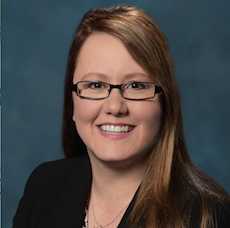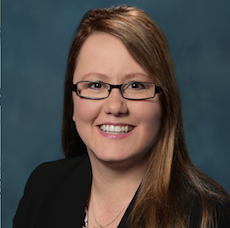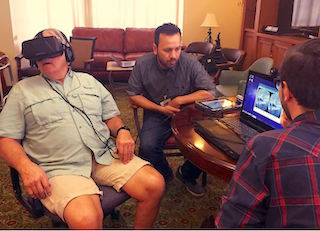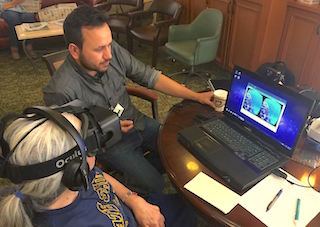

I got my first look at virtual reality in April during the Cleveland International Film Festival. A new part of the annual event brought 10 virtual reality short films to participants, and I watched three of them.
The one that has stayed with me the most is “Sisters: A Mobile VR Ghost Story.” When I placed the virtual reality headset (similar to a very thick set of goggles with a smartphone attached the the front) on my noggin, I was transported to an old house on a dark and stormy night. The 360-degree world in the four-minute horror film felt so real that at one point I screamed (and then laughed at myself for doing so), even though the setting and characters were animated — and even though I had seen my husband’s similar reaction when he had watched the film before I did.
If you ever have the chance to see that movie, I highly recommend it. As part of the senior living industry, however, you soon may have the opportunity to apply virtual reality in much more practical and meaningful ways.
In fact, Davis Park, director of the Front Porch Center for Innovation and Wellbeing, predicts “some kind of full-scale deployment” of virtual reality technology at his organization within the next 12 to 18 months.
“We’re finding that there are more and more applications of this kind of technology in senior living,” he tells me.
The FPCIW, Park says, has been pilot-testing several virtual reality programs in an effort to make the technology more useful for older adults.
Among the discoveries of usability testing for the University of Southern California were that the current headsets are too heavy for many seniors and that many older adult users wish to experience peaceful environments, he says. (Watch a resident of Front Porch’s Villa Gardens experience virtual reality in the video at the end of this column.)
A demonstration project with 3Scape Systems of Canada revealed that the company’s three-dimensional movies designed for seniors, based on reminiscence therapy, evoked strong emotions in residents.
“They create these amazing landscape visuals with characters that hark back to the ‘old days,’ ” Park says of the company. Some of the visuals in the 30- to 40-minute films include a grandfather and granddaughter going fishing in a rowboat on a river, a grandmother baking cookies with her granddaughter and kittens playing in a basket, he adds.
“People watch these things, and they’re so engaged with it,” Park says. “Some of them come out of this experience weeping — ‘Oh my gosh, it reminds me of baking pies when I was that age.’ ”
When the FPCIW pilot-tested the experiences in a Front Porch community, the residents who participated enthusiastically talked about it with their friends, which drew them into conversations about their past, Park says.
“People were like, ‘Where was that scene shot?’ ‘Oh, it was done at the Colorado Rockies.’ One of the residents, who did not speak at all throughout this whole conversation, said, ‘Oh, I’ve been to Colorado. In fact, that’s where I lived under the internment of Japanese-Americans.’ Everybody’s like, ‘Oh my God. Really?’ ” he says. “It opened up all these amazing conversations and experiences that created a larger community as a result of people going through this screening together.”
A recently concluded pilot program with start-up company Lumeum, using Oculus Rift DK2 technology, enabled residents of Front Porch’s Kingsley Manor community in Los Angeles to reminisce and travel the world, virtually.
Lumeum, a content curator rather than a developer, Park says, sought to discover seniors’ ideal virtual relaxation environments.


At left: Kingsley Manor resident John Bill experiences virtual reality with Max Orozco, center, and Noah Orozco of Lumeum. In the photo at right, resident Gloria Coomb wears the headset.
“People are squealing with laughter, they’re giggling, and it’s so neat to see people engaged at that level,” he says of residents who have participated in the project. “Their reactions have really been heartwarming, to see people finally get a chance to see what all the hoopla is about virtual reality and get something really neat out of that experience.”
The next phase of the pilot and usability testing with Lumeum will include homebound residents, Park says.
“We’ve been primarily doing a lot of this testing with independent living residents who are very able-bodied. They can get out and about,” he says. “The group that we ultimately want to target are those who can’t get out of their homes. How do we reach those who can’t even come out to a community meeting or can’t participate because they can’t get out of the bed? How can we bring these experiences to those who’ve lost their ability to walk or just to simply get around?”
Ultimately, Park says, virtual reality may be a common way for residents to check items off of their bucket lists. “If you haven’t been to Hawaii, then we can bring Hawaii to you,” he says.
And one day, Park says, it may allow residents to “meet” their children or grandchildren in virtual spaces.
“I’m not a technology futurist, but my guess is that definitely, within the next five years, we’re going to be seeing something like that, where people will be able to create environments and come together in these virtual meeting rooms and spaces,” he says.
And residents may be able to visit places from their past via virtual reality.
“If I can’t see my mom because of distance or for whatever reason, if I can shoot a three-dimensional movie of her home where she grew up or her favorite tree and send it to her, she can experience that at her community,” Park says. “There are all kinds of possibilities for social connectivity, for social engagement, for connecting family members and loved ones and relatives. That’s the direction that I would love to go.”
Facebook’s recent purchase of Oculus Rift “is an important indication as to where this technology is headed” for social purposes, Park says.
And the technology has shown promise for clinical purposes, too.
USC researchers are studying virtual reality’s ability to rebuild neural pathways in those who are recovering from stroke, for instance, Park says. “It uses some feedback mechanisms like electroencephalograms and electrocardiograms to read brain waves and to see what areas of the brain are receptive to your arm movements as you’re directed to move them in your virtual environment,” he explains.
Virtual reality also is showing promise for pain management and dementia care, Park says.
“It helps in redirection,” he explains. “If someone has high anxiety levels, for example, or someone is sundowning. You can use this kind of virtual reality experience to ease their anxieties and help produce a level of calm in them.”
Other recent studies have shown that the technology has potential in preventing falls in older adults, detecting mild cognitive impairment, evaluating balance control in people with glaucoma and helping people with depression be less critical and more compassionate toward themselves.
I’d see the “Sisters” movie again in a heartbeat, but the potential applications of virtual reality in senior living excite me even more.
Watch a resident of Front Porch’s Villa Gardens experience virtual reality in this Front Porch video:
Lois A. Bowers is senior editor of McKnight’s Senior Living. Contact her at [email protected]. Follow her on Twitter at @Lois_Bowers.

